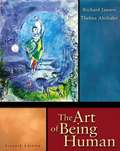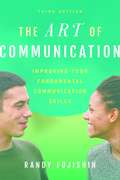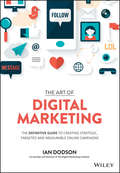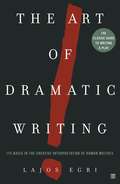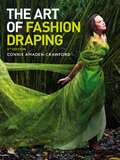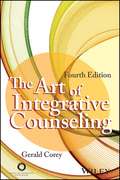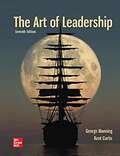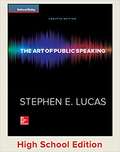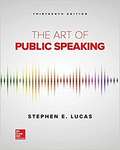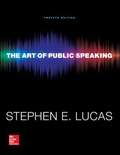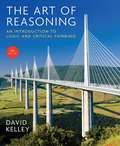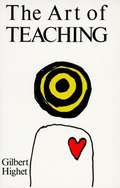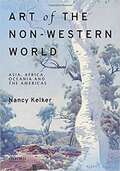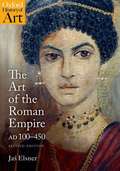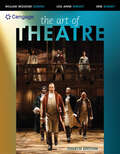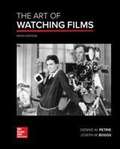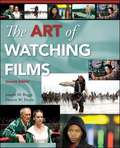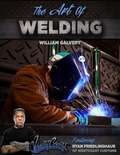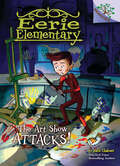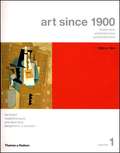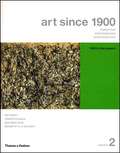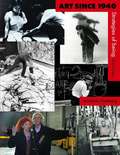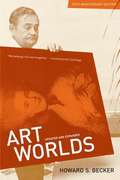- Table View
- List View
The Art of Being Human (Seventh Edition)
by Thelma Altshuler Richard JanaroThe Art of Being Human introduces readers to the ways in which the humanities can broaden their perspective, enhance their ability to think critically and creatively, and enrich their lives. This highly-respected book has been lauded for its scope of topics, accessibility, and lucid writing style. Chapter topics include myth, literature, art, music, television, cinema, and the theater. Also discussed are provocative issues in the humanities - religion, morality, happiness, death, freedom, and controversies in the arts. The thematic organization of the book allows readers to concentrate on one artistic mode at a time
The Art Of Communication: Improving Your Fundamental Communication Skills (Third Edition)
by Randy FujishinThis third edition of The Art of Communication (previously titled Creating Communication) is a brief and practical introduction to speech communication. Emphasizing face-to-face communication, yet also addressing the role of technology and its influence on daily communication, Fujishin helps you develop greater understanding of how important communication skills are in your personal and professional life--and will inspire you to use these skills in ways that enlarge and improve the lives of others as well as your own. Fujishin employs a distinctively encouraging and conversational approach as he explains the basic communication skills necessary to improve in numerous contexts--including public speaking, small group, interpersonal, intercultural, leadership, interviewing, and technology-based communication. The result is an easy-to-read book that provides the tools to implement powerful changes in the ways you interact with others.
The Art of Digital Marketing: The Definitive Guide to Creating Strategic, Targeted, and Measurable Online Campaigns
by Ian DodsonThe premier guide to digital marketing that works, and a solid framework for success The Art of Digital Marketing is the comprehensive guide to cracking the digital marketing 'code,' and reaching, engaging, and serving the empowered consumer. Based on the industry's leading certification from the Digital Marketing Institute (DMI), this book presents an innovative methodology for successful digital marketing: start with the customer and work backwards. <p><p> A campaign is only effective as it is reflective of the consumer's wants, needs, preferences, and inclinations; the DMI framework provides structured, implementable, iterative direction for getting it right every time. The heart of the framework is a three-step process called the 3i Principles: Initiate, Iterate, and Integrate. This simple idea translates into higher engagement, real customer interaction, and multichannel campaigns that extend even into traditional marketing channels. The evolution of digital marketing isn't really about the brands; it's about consumers exercising more control over their choices. <p> This book demonstrates how using this single realization as a starting point helps you build and implement more effective campaigns. Instead of telling the customer what to think, you find out what they already think and go from there. Instead of front-loading resources, you continually adjust your approach based on real interactions with real customers every day. Digital marketing operates within its own paradigm, and The Art of Digital Marketing opens the door for your next campaign.
The Art of Dramatic Writing: Its Basis in the Creative Interpretation of Human Motives
by Lajos EgriLearn the basic techniques every successful playwright knows Among the many "how-to" playwriting books that have appeared over the years, there have been few that attempt to analyze the mysteries of play construction. Lajos Egri's classic, The Art of Dramatic Writing, does just that, with instruction that can be applied equally well to a short story, novel, or screenplay. Examining a play from the inside out, Egri starts with the heart of any drama: its characters. All good dramatic writing hinges on people and their relationships, which serve to move the story forward and give it life, as well as an understanding of human motives -- why people act the way that they do. Using examples from everything from William Shakespeare's Romeo and Juliet to Henrik Ibsen's A Doll's House, Egri shows how it is essential for the author to have a basic premise -- a thesis, demonstrated in terms of human behavior -- and to develop the dramatic conflict on the basis of that behavior. Using Egri's ABCs of premise, character, and conflict, The Art of Dramatic Writing is a direct, jargon-free approach to the problem of achieving truth in writing.
The Art of Fashion Draping
by Connie Amaden-Crawford“This is the most comprehensive teaching tool for learning and mastering draping techniques. The illustrations and the text for each drape are clear and explicit.” Laura K. Kidd, Southern Illinois University, USA <p><p> Learn to drape fabric on a dress form to create your own patterns. <p><p> The step-by-step instructions are organized from basic to advanced projects using both imperial and metric measurements, so you don't have to convert measurements. The book includes a wide variety of fashion styles, from bodices to bias-cut gowns. Intermediate and advanced design variations include an off-shoulder sleeve design and a peplum design. More than 1,000 two-color line drawings show you each draping step. <p> - Checklists to evaluate and analyze designs <p>- Cross-referencing of techniques across chapters <p>- Online STUDIO includes video tutorials explaining key draping skills and techniques <p>- Lay-flat binding makes the book easy to use while draping garments
The Art of Integrative Counseling
by Gerald CoreyUseful as a supplemental text in advanced theories and practicum courses, this fourth edition discusses the key concepts and techniques from many contemporary theories and how to develop an integrative approach to the counseling process to better meet individual client needs. Dr. Corey introduces the techniques that he draws from in his own integrative approach to counseling using a wide variety of case examples with diverse clients. Topics covered include assessing presenting issues; developing a productive working alliance; establishing therapeutic goals; understanding and addressing diversity; working with resistant clients; using evidence-based practice in cognitive, emotive, and behavioral work with clients; dealing with transference and countertransference; and incorporating trends in integrative therapies. To encourage active learning, reflective exercises throughout the text provide readers with opportunities to put themselves in the role of therapist and client.
The Art of Leadership
by George Manning Kent CurtisThe Art of Leadership is based on two ideas: 1. Leadership will take place to the extent the leader cares about the work to be done. Equally important, the leader must care about people. Neither of these qualities is sufficient without the other, and neither can be false. People know when the leader cares. When the leader is committed to the task and is concerned about people, these qualities serve as magnets and motivators to followers, and their potential for achievement becomes enormous. <p><p> 2. Leadership is an art that can be developed through mastery of nine key areas of success. The successful leader must possess knowledge and skills in the following areas: understanding leadership variables, the power of vision, the importance of ethics, the empowerment of people, leadership principles, understanding people, multiplying effectiveness, developing others, and performance management. <p><p>The difference between most other leadership texts and the Art of Leadership can be compared to the difference between a lecture and seminar. Although both are good educational vehicles, the lecture is better for conveying large amounts of information, while the seminar is better for developing skills and attitudes. A good lecture is interesting and builds knowledge, while a good seminar is stimulating and builds competency. Without sacrificing either theoretical foundation or important content, the 6th edition of The Art of Leadership emphasizes the interactive, seminar approach to learning. <p><p>The 7th edition remains reader-centered, research-based, practical, and personalized. The Instructor Resources for the 7th edition have been vastly enhanced, including the PowerPoint and test bank.
The Art Of Public Speaking
by Stephen Lucas Paul StobFully updated for the thirteenth edition, the award-winning The Art of Public Speaking offers a time-tested approach that has made it the most widely used college textbook on its subject in the world. Seamlessly coordinated with Connect, McGraw-Hill Education's pathbreaking online program, it supplies a proven set of teaching and learning tools that is without parallel among public speaking books.
The Art of Public Speaking 12th Edition
by Stephen LucasThe Art of Public Speaking personalizes learning for every student no matter who they are or where they are, ensuring that they come to your public speaking class confident, prepared with the principle foundations, and ready to participate in your teaching and coaching. Connect is the only integrated learning system that empowers students by continuously adapting to deliver precisely what they need, when they need it, and how they need it, so that your class time is more engaging and effective.
The Art of Reasoning: An Introduction to Logic and Critical Thinking (Fourth Edition)
by David KelleyDesigned for courses in introductory logic or critical thinking. In addition to the elements of formal deductive logic, it includes classification and definition, basic argument analysis, fallacies, and inductive reasoning.
The Art of Teaching
by Gilbert HighetThe noted classicist presents his educational methodology, within the context of history, from the Sophists to modern teaching.
Art of the Non-Western World: Asia, Africa, Oceania, and the Americas
by Nancy L. KelkerArt of the Non-Western World: Asia, Africa, Oceania, and the Americas gives students the tools to better understand and appreciate the arts in a global world. It offers an in-depth, contextual exploration of the art from the larger world beyond the European tradition, including painting, sculpture, pottery, graphic arts, and architecture of Asia, the Americas, Africa, Australia, and the Pacific Islands, from the Neolithic to the Contemporary. All new print and electronic versions of Art of the Non-Western World come with access to a full suite of engaging digital learning tools.
The Art of the Roman Empire: 100-450 AD, Second Edition (Oxford History of Art)
by Jas EisnerThe passage from Imperial Rome to the era of late antiquity, when the Roman Empire underwent a religious conversion to Christianity, saw some of the most significant and innovative developments in Western culture. This stimulating book investigates the role of the visual arts, the great diversity of paintings, statues, luxury arts, and masonry, as both reflections and agents of those changes. <P><P>Jas' Elsner's ground-breaking account discusses both Roman and early Christian art in relation to such issues as power, death, society, acculturation, and religion. By examining questions of reception, viewing, and the culture of spectacle alongside the more traditional art-historical themes of imperial patronage and stylistic change, he presents a fresh and challenging interpretation of an extraordinarily rich cultural crucible in which many fundamental developments of later European art had their origins. <P><P>This second edition includes a new discussion of the Eurasian context of Roman art, an updated bibliography, and new, full colour illustrations.
The Art of Theatre: Then and Now
by William Missouri Downs Erik Ramsey Lou Anne WrightTHE ART OF THEATRE: THEN AND NOW, 4th Edition, brings the fascinating world of theatre to life with lively coverage of the history, cultural diversity, creativity, controversy -- and even a typical day in the life -- of theatre. As the authors wrote each chapter, they asked themselves how the subject applies to students' lives. The result is a text packed with practical information you can use in everyday life, including insight on censorship, freedom of speech, copyrights, the National Endowment for the Arts, and more. Timely connections drawn between theatre and TV and film help you see how the living stage is unique, and the optional MindTap digital learning solution provides a variety of online study tools to help you ensure your success in the course.
The Art Of Watching Films
by Dennis W. Petrie Joe BoggsWith an emphasis on the narrative film, The Art of Watching Films, 9e challenges students to take their film experience further by sharpening their powers of observation, developing the skills and habits of perceptive watching, and discovering complex aspects of film art that they might otherwise overlook. This title introduces the formal elements and production process of films, and helps students analytically view and understand films within their historical, cultural and social contexts. The text presents an analytical framework that can be applied to all movies, as distinctly different as Avatar, The Girl with the Dragon Tattoo, Vertigo, Iron-Man, Man on Wire, and The Hurt Locker.
The Art Of Watching Films (Seventh Edition)
by Dennis W. PetrieNot only is there an art to making films, there is also an art to watching films. We wrote this book to challenge students in introduction to film courses to sharpen their powers of observation, develop the skills and habits of perceptive watching, and discover complex aspects of film art that they might otherwise overlook. We designed the text to complement any film studied; its analytical framework can be applied to films as distincly different as The Grapes of Wrath, Caché, Dreamgirls, Batman Begins, Little Miss Sunshine, and Flags of our Fathers.
The Art Of Welding
by William L. Galvery Ryan FriedlinghausRyan Friedlinghaus, the celebrated guru of automotive customization and host of West Coast Customs on Fox Sports, adds practical knowledge to William Galvery's acclaimed welding insight and everyday tips and tricks developed over his long professional career as an educator. This unique and original book improves upon the shortcomings of competitive titles by providing complete, in-depth coverage of the equipment and techniques used in the most popular welding processes: oxyacetylene, stick welding, MIG welding and TIG welding. What's more, it presents information in a lively, easy-to-follow design. Each chapter contains the pros and cons of each process and information on equipment, setup, materials, safety and welding techniques. To provide a solid footing for the novice welder, there is a chapter that provides an overview of welding and another on tools and materials. The bulk of the book is devoted to the more popular welding techniques. The authors also provide a chapter on soldering and brazing and another on plasma cutting. The Art of Welding is perfect for anyone who wants to learn welding, to make repairs or as part of a hobby. Even experienced welders will discover many tips and procedures to improve their welding technique. Features: Presents the accumulated experience and knowledge of two welding professionals. William Galvery provides insight to the proper use of equipment and the science behind welding, including how welding affects different metals. Ryan Friedlinghaus provides the tips and techniques he uses everyday at West Coast Customs. Offers in-depth information about all popular welding processes, step-by-step photos and an engaging design that will appeal to do-it-yourselfers and hobbyist who want a solid background in welding. Emphasis is placed on safety with sections on selecting the proper clothing and safety lens for welding. Each welding process includes tips on approaching the job in a safe manner. Contains troubleshooting guides offering users an opportunity to learn from their mistakes by comparing inadequate welds to the troubleshooting guides located throughout the book. A chapter on welding projects shows welders how to compensate for the natural distortion that welding causes to various metals
The Art Show (Fountas & Pinnell Classroom, Guided Reading)
by Lisa Klobuchar Robert ReynoldsNIMAC-sourced textbook. My Art. Everybody can make art. Read to find out what a group of children make for their art show.
The Art Show Attacks!: A Branches Book (Eerie Elementary #9)
by Jack ChabertNew York Times bestselling author Jack Chabert knows how to keep young readers on the edge of their seats!Pick a book. Grow a Reader!This series is part of Scholastic's early chapter book line, Branches, aimed at newly independent readers. With easy-to-read text, high-interest content, fast-paced plots, and illustrations on every page, these books will boost reading confidence and stamina. Branches books help readers grow!In the ninth book of this spooky series, Eerie Elementary is having an art show. Sam is working on his project for the show when suddenly the clay he's working with comes ALIVE! Then Sam and his friends start seeing signs of mad scientist Orson Eerie everywhere. First Orson's face mysteriously appears on a painting, then he leads them to a new, secret room in the school. What is Orson up to this time? Is he trying to spread his creepy power outside school grounds yet again? Sam and his friends need to act FAST!
Art since 1900: Modernism, Antimodernism, Postmodernism (Volume 1, 1900-1944)
by Hal Foster Yve-Alain Bois Benjamin H. D. Buchloh Rosalind E. KraussIn this groundbreaking and original work of scholarship, four of the most influential and provocative art historians of our time have come together to provide a comprehensive history of art in the twentieth century, an age when artists in the United States, Europe, and elsewhere sought to overturn the traditions of the past and expectations of the present in order to invent new practices and forms. Adopting a unique year-by-year approach, Foster, Krauss, Bois, and Buchloh present more than 50 short essays, each focusing on a crucial event the creation of a seminal work, the publication of an artistic manifesto, the opening of a major exhibition to tell the story of the dazzling diversity of practice and interpretation that characterizes the art of the period. All the turning points and breakthroughs of modernism and postmodernism are explored in depth, as are the frequent and sustained antimodernist reactions that proposed alternative visions of art and the world. Illustrating the authors' texts are more than 300 of the most important works of the century, many reproduced in full color. The book's flexible structure and extensive cross-referencing allow readers to follow any one of the many narratives that unfold, whether that be the history of a medium such as photography or painting, the development of art in a particular country, the influence of a movement such as surrealism or feminism, or the emergence of a stylistic or conceptual category like abstraction or minimalism. Boxes give further background information on the important figures and issues. In their insightful introductions, the four authors explain the different methods of art history at work in the book, providing the reader with the conceptual tools for further study. A roundtable discussion at the close of the book considers the questions raised by the preceding decades and look ahead to the art of the future. A glossary of terms and concepts completes this extraordinary volume.
Art since 1900: Modernism, Antimodernism, Postmodernism (Volume 2, 1945-Present)
by Hal Foster Yve-Alain Bois Benjamin H. D. Buchloh Rosalind E. KraussIn this groundbreaking and original work of scholarship, four of the most influential and provocative art historians of our time have come together to provide a comprehensive history of art in the twentieth century, an age when artists in the United States, Europe, and elsewhere sought to overturn the traditions of the past and expectations of the present in order to invent new practices and forms. Adopting a unique year-by-year approach, Foster, Krauss, Bois, and Buchloh present more than 100 short essays, each focusing on a crucial event the creation of a seminal work, the publication of an artistic manifesto, the opening of a major exhibition to tell the story of the dazzling diversity of practice and interpretation that characterizes the art of the period. All the turning points and breakthroughs of modernism and postmodernism are explored in depth, as are the frequent and sustained antimodernist reactions that proposed alternative visions of art and the world. Illustrating the authors' texts are more than 600 of the most important works of the century, many reproduced in full color. The book's flexible structure and extensive cross-referencing allow readers to follow any one of the many narratives that unfold, whether that be the history of a medium such as photography or painting, the development of art in a particular country, the influence of a movement such as surrealism or feminism, or the emergence of a stylistic or conceptual category like abstraction or minimalism. Boxes give further background information on the important figures and issues. In their insightful introductions, the four authors explain the different methods of art history at work in the book, providing the reader with the conceptual tools for further study. Two roundtable discussions one at midcentury, the other at the close of the book consider the questions raised by the preceding decades and look ahead to the art of the future. A glossary of terms and concepts completes this extraordinary volume.
Art since 1940
by Jonathan David FinebergThis comprehensive and authoritative textbook illustrates art from the 1940's and stresses the individuality of the artists in relation to their political, social, and cultural contexts. The book focuses on the meaning of the major works and innovations. It features nearly 600 illustrations (approximately half in color) representing art since 1940, both in Europe and America. It explores the full range of periods, artists, and movements: New York in the Forties; Calder, Hofmann, Gorky, Motherwell, De Kooning; Existentialism (Pollock, Newman, Rothko, David Smith); The New European Masters of the Late Forties (Dubuffet, Giacometti, Bacon), plus so much more. For anyone interested in Postwar Art.
Art That Heals / Maya Lin: Building Remembrance (Fountas & Pinnell Classroom, Guided Reading)
by Mm EbochNIMAC-sourced textbook
Art Worlds
by Howard S. BeckerThis classic sociological examination of art as collective action explores the cooperative network of suppliers, performers, dealers, critics, and consumers who - along with the artist - "produce" a work of art. Howard S. Becker looks at the conventions essential to this operation and, prospectively, at the extent to which art is shaped by this collective activity. The book is thoroughly illustrated and updated with a new dialogue between Becker and eminent French sociologist Alain Pessin about the extended social system in which art is created, and with a new preface in which the author talks about his own process in creating this influential work.
